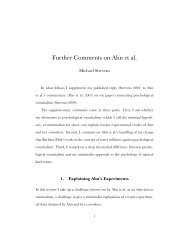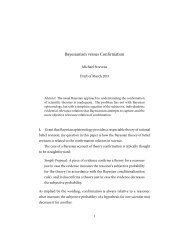The Essentialist Aspect of Naive Theories - Michael Strevens
The Essentialist Aspect of Naive Theories - Michael Strevens
The Essentialist Aspect of Naive Theories - Michael Strevens
You also want an ePaper? Increase the reach of your titles
YUMPU automatically turns print PDFs into web optimized ePapers that Google loves.
the difference, but the level <strong>of</strong> logical and theoretical sophistication required<br />
by the particular inference.<br />
It is also worth noting that in S. Gelman and Markman (1987), some<br />
three and four-year-olds’ inferences involved categorizations (see note 8).<br />
Since the projections in these inferences were mediated by K-laws, it seems<br />
reasonable to assume that the categorizations were too, although there is<br />
no direct evidence for this assumption. If the assumption is correct, three<br />
and four-year-olds are in many cases making projections and categorizations<br />
with equal facility.<br />
2.4 Other Explanations <strong>of</strong> the K-patterns<br />
<strong>The</strong> hypothesis that children believe K-laws is the only hypothesis that can<br />
account for all aspects <strong>of</strong> the K-patterns. This becomes evident as one moves<br />
step by step from the explanation <strong>of</strong> Gelman’s experiments on projection<br />
through to the explanation <strong>of</strong> Keil’s transformation experiments:<br />
Gelman’s Projection Experiments: Any theory structure that posits a strong<br />
link between category and behavior but does not postulate an unbreakable<br />
link between category and appearances can account for Gelman’s<br />
results, since on any such theory, (a) the child can infer that all squirrels<br />
behave the same way, and (b) the child can learn that rabbits eat grass<br />
without thereby committing to the belief that all rabbit-shaped creatures<br />
eat grass. It is not necessary to posit a representation <strong>of</strong> a causal law<br />
linking category and behavior. For example, Gelman’s results can be<br />
explained by the hypothesis that children consider certain behaviors to<br />
be necessary and sufficient for category membership. <strong>The</strong>n squirrels<br />
must eat bugs, or they would not be squirrels, but there is nothing causal<br />
about it.<br />
Keil’s Discovery Experiment: <strong>The</strong> discovery experiment shows that the child<br />
considers the laws linking kind and observable properties to have exceptions.<br />
<strong>The</strong>y do not, however, show that these laws are causal. <strong>The</strong> laws<br />
might be non-causal statistical generalizations.<br />
Keil’s Transformation Experiments: With the transformation experiments<br />
(assuming the explanation from artificiality) it becomes apparent that information<br />
about the abnormality <strong>of</strong> causal processes inclines older children<br />
to refrain from making inferences based on the laws linking kind<br />
18






